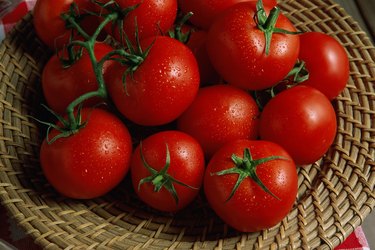
Harvesting a perfectly ripe, tasty, home-grown tomato (Solanum lycopersicum) is one of the joys of gardening. To reach that goal, you need to know what type of tomato best suits your gardening conditions and spaces. One of the basic decisions is whether to grow determinate or indeterminate tomato varieties. Determinate tomatoes stop growing once the branches start to set fruit. Indeterminate tomatoes don't stop growing until frost kills them; they have a vining habit and are often large, sprawling plants. Determinate tomato plants are usually shorter, bushier, earlier-bearing and less productive than indeterminate plants.
Cherry and Grape Tomatoes
Video of the Day

If you have limited space, opt for small determinate cherry tomatoes such as early season "Tumbler," growing 12 to 16 inches tall and 18 inches wide, and midseason "Patio Princess," 24 inches tall and 18 inches wide. Both are excellent for growing in containers. For a large plant, try "Mighty Sweet," a midseason determinate grape tomato that reaches 60 inches tall with a spread of 45 inches.
Video of the Day
Red Medium to Large Tomatoes

Round, red, flavorful tomatoes that are large enough for slicing for sandwiches, salads and cooking are the mainstay of the garden. Determinate varieties, with their faster maturation, are well-suited for areas with shorter growing seasons. Examples are silver-dollar-sized "Oregon Spring," ripening in 60 to 70 days, and large-fruited "Legend," with ripe fruit 60 to 65 days after transplanting to the garden.
Yellow and Orange Varieties

Yellow and orange tomatoes usually have milder flavor than red varieties. Determinate varieties include early-season "Orange Blossom" with round, orange, 6- to 7-ounce tomatoes and "Carolina Gold," a disease-resistant, bright gold, beefsteak type tomato with a sweet, mild flavor. It ripens in 71 days.
Heirloom Cultivars

Prized for the richness and complexity of their flavors as well as for their interesting shapes and colors, heirlooms are older varieties passed down from generation to generation. Most heirloom tomatoes are indeterminate, but the determinate heirloom "Principe Borghese," originated in Italy primarily for use as dried tomatoes. "Principe Borghese" is also good fresh and in cooking. Abundant small fruits occur in clusters. "Marglobe" dates from 1925, introduced by the U.S. Department of Agriculture. It bears large, globe-shaped fruit that ripen all at once in about 73 days. "Rutgers," another determinate heirloom, grows 4 to 5 feet tall and ripens in 73 days. Fruits have thick, firm flesh and superior taste.
Cultural Information

Tomatoes are native to South America. Introduced into Europe with returning Spanish explorers, tomatoes spread worldwide, with many varieties developed from the parent stock. All tomatoes are frost-tender, hardy only in U.S. Department of Agriculture plant hardiness zones 10 through 11. They're usually grown as annuals. Tomatoes need full sun and rich, well-draining soil. The fast-growing plants need regular watering during their growing season.